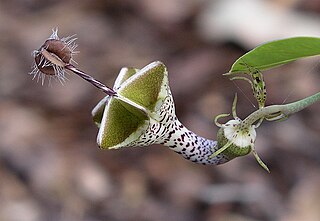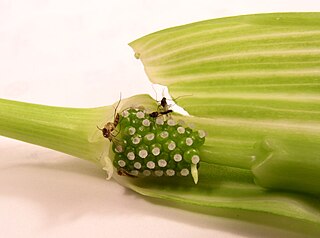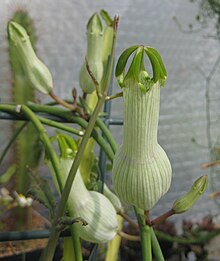
Apocynaceae is a family of flowering plants that includes trees, shrubs, herbs, stem succulents, and vines, commonly known as the dogbane family, because some taxa were used as dog poison. Members of the family are native to the European, Asian, African, Australian, and American tropics or subtropics, with some temperate members. The former family Asclepiadaceae is considered a subfamily of Apocynaceae and contains 348 genera. A list of Apocynaceae genera may be found here.

The Asclepiadoideae are a subfamily of plants in the family Apocynaceae. Formerly, they were treated as a separate family under the name Asclepiadaceae, e.g. by APG II, and known as the milkweed family.

Ceropegia is a genus of plants within the family Apocynaceae, native to Africa, southern Asia, and Australia. It was named by Carl Linnaeus, who first described this genus in his Genera plantarum, which appeared in 1737. Linnaeus referred to the description and picture of a plant in the Horti Malabarici as the plant for which the genus was created. In 1753 he named this species as Ceropegia candelabrum. Linnaeus did not explain the etymology but later explanations stated that the name Ceropegia was from the Greek word keropegion κηροπηγɩον. This means candelabrum in Latin, which has a broader range than the modern word - "a candlestick, a branched candlestick, a chandelier, candelabrum, or also lamp-stand, light-stand, sometimes of exquisite workmanship".

Stapeliinae is a subtribe of flowering plants within the tribe Ceropegieae of the subfamily Asclepiadoideae of the family Apocynaceae. The subtribe comprises about 35 genera, including both the stem-succulent "stapeliads" and the horticulturally popular genera Brachystelma and Ceropegia. The largest number of genera are native to Africa, but a more limited number of genera are widespread in Arabia and Asia. Historically, a similarly circumscribed taxon was treated as a separate tribe, Stapelieae.

Cynanchum is a genus of about 300 species including some swallowworts, belonging to the family Apocynaceae. The taxon name comes from Greek kynos and anchein, hence the common name for several species is dog-strangling vine. Most species are non-succulent climbers or twiners. There is some evidence of toxicity.

Ceropegia stapeliiformis is a flowering plant in the genus Ceropegia (Apocynaceae), native to South Africa and Eswatini. Common names include serpent ceropegia, snake creeper, and slangkambro.

Vincetoxicum rossicum is a flowering plant in the family Apocynaceae. It is a perennial herb native to southern Europe and is a highly invasive plant growing in all of the Eastern United States, in the mid west, and southern Ontario and Quebec in Canada. It has several common names including swallowwort, pale swallowwort, and dog-strangling vine; though it does not actually strangle dogs, it can “strangle” native plants and small trees if it is in dense patches. There has historically been much confusion about the genus it belongs to, with authors placing it within Vincetoxicum and others within Cynanchum, but recent molecular and chemical analyses have shown it to belong in the genus Vincetoxicum.

Ceropegia sandersonii is a species of flowering plant in the family Apocynaceae that is native to Mozambique, South Africa, and Eswatini. Common names are parachute plant, fountain flower, and umbrella plant.

Edithcolea is a monotypic genus with a single species Edithcolea grandis. Once classified in the family Asclepiadaceae, it is now in the subfamily Asclepiadoideae of the dogbane family Apocynaceae. It is native to eastern Africa and to the Arabian Peninsula.

Cynanchum viminale is a leafless succulent plant in the family Apocynaceae. The species is native to West Africa, the Indian Ocean and Western Pacific region. The species' natural range extends from South Africa throughout much of Africa and the Middle East to India, Indochina, Southern China, Indomalaya and into Meganesia. The species is also found on several Indian Oceans islands including Mauritius, Réunion and the Seychelles.
Tweedia is a genus of flowering plants in the family Apocynaceae, first described as a genus in 1835. The genus is native to South America. An ornamental plant, Oxypetalum coeruleum, formerly included in this genus is commonly referred to as "tweedia".
- Tweedia andina(Phil.) G.H.Rua - Chile
- Tweedia aucaensisG.H. Rua - Argentina
- Tweedia australis(Malme) C. Ezcurra - Argentina
- Tweedia birostrata(Hook. & Arn.) Hook. & Arn. - Chile
- Tweedia brunonisHook. & Arn. - Argentina, Bolivia, Paraguay
- Tweedia echegarayi(Hieron.) Malme - Argentina
- Tweedia solanoides(Hook. & Arn.) Chittenden - Argentina, Brazil, Paraguay, Uruguay
Ceropegia striata is a plant species endemic to Madagascar. It is known only from the Vavavato Massif in the central highlands, at an elevation of approximately 1800 m.

Pollination traps or trap-flowers are plant flower structures that aid the trapping of insects, mainly flies, so as to enhance their effectiveness in pollination. The structures of pollination traps can include deep tubular corollas with downward pointing hairs, slippery surfaces, adhesive liquid, attractants, flower closing and other mechanisms.

Ceropegia candelabrum is the type species in its genus of plants, belonging the subfamily Asclepiadoideae. The Latin specific epithet candelabrum is derived from the candelabra-like appearance of the inflorescences.
Leichhardtia mackeeorum, synonym Marsdenia mackeeorum, is a species of vine in the family Apocynaceae. It is endemic to New Caledonia.
Vincetoxicum lineare is a species of plant in the family Apocynaceae native to Australia. Known as the bush bean, it is an edible species of plant found in arid regions. As Rhyncharrhena linearis, the species was at one time the only species in the monotypic genus Rhyncharrhena.
Funastrum angustifolium is a plant species. Commonly known as the Gulf coast swallow-wort, it is a perennial dicot that grows in the southern United States as far west as Texas. It is in the Cynanchum genus and Apocynaceae family. A flowering vine, it produces white blossoms with greenish and yellow parts. A member of the milkweed family, it is a plant host for monarch butterflies and produces wind dispersed seed pods.
Vincetoxicum forsteri is a species of plant in the dogbane family Apocynaceaethat is endemic to Australia. It was first described by Paul Irwin Forster in 1992 as Tylophora linearis.

Ruehssia is a genus of plants in the family Apocynaceae. It is also in the Asclepiadoideae subfamily and Marsdenieae tribe.
Cynanchum violator is a species of flowering plant in the family Apocynaceae, native to wet tropical areas of Táchira state, Venezuela. A scrambling subshrub, it is so named because it possesses a number of character traits often used to delimitate sections and even genera in related taxa.













